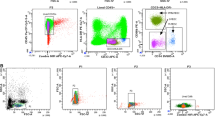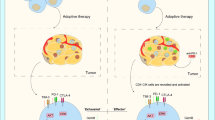Abstract
As a purified active component from traditional Chinese medicine, lentinan administration can be applied as beneficial chemo-immunotherapy for anti-tumor. In this study, the immunomodulatory effects of lentinan on aberrant T subsets and cytokines profile were evaluated for non-small cell lung cancer (NSCLC). Of all NSCLC patients treated with NP chemotherapeutic protocol (combination of vinorelbin and cisplatin), 73 cases were recruited in this retrospective cohort trial study, of which 38 cases received additional lentinan. The changes of aberrant T subsets and cytokines profile were compared between two groups (chemotherapy in combination with lentinan vs. conserved single chemotherapy) by flow cytometry and molecular biology. Higher subset ratio of CD3+CD8+ cytotoxic T cells was confirmed in the peripheral blood of NSCLC patients. Chemo-immunotherapy of lentinan resulted in a significant increase of CD3 + CD56+ NKT cells (15.7 ± 3.1%), compared with 8.6 ± 1.4% of NKT cells in single chemotherapy group, and up-regulated CD3+CD8+ and CD3+CD4+ subsets as well, but caused the decrease of CD4+CD25+ Tregs induction, accompanied by significant alleviation of IL-10 and TGF-β1, and elevation of IFN-γ, TNF-α, and IL-12 (P < 0.05). It could be confirmed that lentinan could not only enhance the cellular immunity and promote the beneficial of anti-tumor by associated immunotherapy, but also had the ability to inhibit the expansion of immune suppressive Tregs in the NSCLC patients, in whom there was a raised Tregs induction compared to health control. Lentinan-based chemo-immunotherapy is a promising strategy for anti-tumor via enhancing the proliferation of cytotoxic T cells, followed by the elevation of inflammatory chemokines/cytokines. Meanwhile, the percentage of CD4+ CD25+ Tregs is down-regulated, leading to a shift in the inflammatory status from Th2 to Th1 in NSCLC patients treated with lentinan.




Similar content being viewed by others
References
Tolcher AW, Patnaik A, Papadopoulos KP, Rasco DW, Becerra CR, Allred AJ, Orford K, Aktan G, Ferron-Brady G, Ibrahim N, Gauvin J, Motwani M, Cornfeld M (2015) Phase I study of the MEK inhibitor trametinib in combination with the AKT inhibitor afuresertib in patients with solid tumors and multiple myeloma. Cancer Chemother Pharmacol 75:183–189
Guo Q, Li J, Lin H (2015) Effect and molecular mechanisms of traditional Chinese medicine on regulating tumor immunosuppressive microenvironment. Biomed Res Int 2015:261620
Tanaka K, Ishikawa S, Matsui Y, Tamesada M, Harashima N, Harada M (2011) Oral ingestion of Lentinula edodes mycelia extract inhibits B16 melanoma growth via mitigation of regulatory T cell-mediated immunosuppression. Cancer Sci 102:516–521
Nagashima Y, Sanpei N, Yamamoto S, Yoshino S, Tangoku A, Oka M (2005) Evaluation of host immunity and side effects in breast cancer patients treated with adjuvant chemotherapy (FEC therapy). Gan To Kagaku Ryoho 32:1550–1552
Okuno K, Uno K (2011) Efficacy of orally administered Lentinula edodes mycelia extract for advanced gastrointestinal cancer patients undergoing cancer chemotherapy: a pilot study. Asian Pac J Cancer Prev 12:1671–1674
Nakano H, Namatame K, Nemoto H, Motohashi H, Nishiyama K, Kumada K (1999) A multi-institutional prospective study of lentinan in advanced gastric cancer patients with unresectable and recurrent diseases: effect on prolongation of survival and improvement of quality of life. Kanagawa Lentinan Research Group. Hepato-Gastroenterology 46:2662–2668
Wang W, Dai X, Ouyang X (2006) Efficacy of lentinan combined with chemotherapy in advanced non-small cell lung cancer. Zhongguo Fei Ai Za Zhi 9:78–81
Piao BK, Wang YX, Xie GR, Mansmann U, Matthes H, Beuth J, Lin HS (2004) Impact of complementary mistletoe extract treatment on quality of life in breast, ovarian and non-small cell lung cancer patients. A prospective randomized controlled clinical trial. Anticancer Res 24:303–309
Kidd PM (2000) The use of mushroom glucans and proteoglycans in cancer treatment. Altern Med Rev 5:4–27
Yamaguchi Y, Miyahara E, Hihara J (2011) Efficacy and safety of orally administered Lentinula edodes mycelia extract for patients undergoing cancer chemotherapy: a pilot study. Am J Chin Med 39:451–459
Murata Y, Shimamura T, Tagami T, Takatsuki F, Hamuro J (2002) The skewing to Th1 induced by lentinan is directed through the distinctive cytokine production by macrophages with elevated intracellular glutathione content. Int Immunopharmacol 2:673–689
Chehimi J, Trinchieri G (1994) Interleukin-12: a bridge between innate resistance and adaptive immunity with a role in infection and acquired immunodeficiency. J Clin Immunol 14:149–161
Hsieh CS, Heimberger AB, Gold JS, O'Garra A, Murphy KM (1992) Differential regulation of T helper phenotype development by interleukins 4 and 10 in an alpha beta T-cell-receptor transgenic system. Proc Natl Acad Sci U S A 89:6065–6069
Murata Y, Shimamura T, Hamuro J (2002) The polarization of T(h)1/T(h)2 balance is dependent on the intracellular thiol redox status of macrophages due to the distinctive cytokine production. Int Immunol 14:201–212
Karpus WJ, Swanborg RH (1989) CD4+ suppressor cells differentially affect the production of IFN-gamma by effector cells of experimental autoimmune encephalomyelitis. J Immunol 143:3492–3497
D'Andrea A, Aste-Amezaga M, Valiante NM, Ma X, Kubin M, Trinchieri G (1993) Interleukin 10 (IL-10) inhibits human lymphocyte interferon gamma-production by suppressing natural killer cell stimulatory factor/IL-12 synthesis in accessory cells. J Exp Med 178:1041–1048
Suzuki M, Kikuchi T, Takatsuki F, Hamuro J (1994) Curative effects of combination therapy with lentinan and interleukin-2 against established murine tumors, and the role of CD8-positive T cells. Cancer Immunol Immunother 38:1–8
Chen C, Chen D, Zhang Y, Chen Z, Zhu W, Zhang B, Wang Z, Le H (2014) Changes of CD4+CD25+FOXP3+ and CD8+CD28- regulatory T cells in non-small cell lung cancer patients undergoing surgery. Int Immunopharmacol 18:255–261
Filaci G, Fenoglio D, Fravega M, Ansaldo G, Borgonovo G, Traverso P (2007) CD8+ CD28- T regulatory lymphocytes inhibiting T cell proliferative and cytotoxic functions infiltrate human cancers. J Immunol 179:4323–4334
Tsukishiro T, Donnenberg AD, Whiteside TL (2003) Rapid turnover of the CD8(+)CD28(−) T-cell subset of effector cells in the circulation of patients with head and neck cancer. Cancer Immunol Immunother 52:599–607
Karagöz B, Bilgi O, Gümüs M, Erikçi AA, Sayan O, Türken O, Kandemir EG, Oztürk A, Yaylaci M (2010) CD8+CD28- cells and CD4+CD25+ regulatory T cells in the peripheral blood of advanced stage lung cancer patients. Med Oncol 27:29–33
Meloni F, Morosini M, Solari N, Passadore I, Nascimbene C, Novo M (2006) Foxp3 expressing CD4+CD25+ and CD8+CD28- T regulatory cells in the peripheral blood of patients with lung cancer and pleural mesothelioma. Hum Immunol 67:1–12
Giroux M, Denis F (2005) CD1d-unrestricted human NKT cells release chemokines upon Fas engagement. Blood 105:703–710
Sathyanarayanan V, Neelapu SS (2015) Cancer immunotherapy: strategies for personalization and combinatorial approaches. Mol Oncol 9:2043–2053
Blackburn SD, Shin H, Haining WN, Zou T, Workman CJ, Polley A, Betts MR, Freeman GJ, Vignali DA, Wherry EJ (2009) Coregulation of CD8+ T cell exhaustion by multiple inhibitory receptors during chronic viral infection. Nat Immunol 10:29–37
Wherry EJ (2011) T cell exhaustion. Nat Immunol 12:492–499
Acknowledgements
This research received no specific grant from any funding agency in the public, commercial, or not-for-profit sectors.
Author information
Authors and Affiliations
Contributions
All authors of XEW, YHW, QZ and GMX were involved in the study concept, statistical analysis and preparation of the manuscripts. The co-authors of MP, JZ, MC and LJM were mainly focused on data collection. All authors read and approved the final manuscript.
Corresponding author
Ethics declarations
Conflict of Interest
All authors declare that they have no conflict of interests.
Rights and permissions
About this article
Cite this article
Wang, Xe., Wang, Yh., Zhou, Q. et al. Immunomodulatory Effect of Lentinan on Aberrant T Subsets and Cytokines Profile in Non-small Cell Lung Cancer Patients. Pathol. Oncol. Res. 26, 499–505 (2020). https://doi.org/10.1007/s12253-018-0545-y
Received:
Accepted:
Published:
Issue Date:
DOI: https://doi.org/10.1007/s12253-018-0545-y




